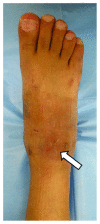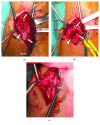Pseudoaneurysm of the Perforating Peroneal Artery following Ankle Arthroscopy
- PMID: 30584485
- PMCID: PMC6280239
- DOI: 10.1155/2018/9821738
Pseudoaneurysm of the Perforating Peroneal Artery following Ankle Arthroscopy
Abstract
The use of standard anterolateral and anteromedial portals in ankle arthroscopy results in reduced risk of vascular complications. Anatomical variations of the arterial network of the foot and ankle might render the vessels more susceptible to injury during procedures involving the anterior ankle joint. The literature, to our knowledge, reports only one case of a pseudoaneurysm involving the peroneal artery after ankle arthroscopy. Here, we report the unusual case of a 48-year-old man in general good health with the absence of the anterior tibial artery and posterior tibial artery. The patient presented with a pseudoaneurysm of the perforating peroneal artery following ankle arthroscopy for traumatic osteoarthritis associated with nonunion of the medial malleolus. The perforating peroneal artery injury was repaired by performing end-to-end anastomosis. The perforating peroneal artery is at higher risk for iatrogenic injury during ankle arthroscopy in the presence of abnormal arterial variations of the foot and ankle, particularly the absence of the anterior tibial artery and posterior tibial artery. Before ankle arthroscopy, surgeons should therefore carefully observe the course of the perforating peroneal artery on enhanced 3-dimensional computed tomography, especially in patients with a history of trauma to the ankle joint.
Figures





Similar articles
-
Pseudoaneurysm of the Anterior Tibial Artery following Ankle Arthroscopy in a Soccer Player.Case Rep Orthop. 2017;2017:2865971. doi: 10.1155/2017/2865971. Epub 2017 May 18. Case Rep Orthop. 2017. PMID: 28607785 Free PMC article.
-
A cadaveric study showing the anatomical variations in the branches of the dorsalis pedis artery at the level of the ankle joint and its clinical implication in ankle arthroscopy.Ann R Coll Surg Engl. 2017 Apr;99(4):286-288. doi: 10.1308/rcsann.2016.0288. Epub 2016 Sep 23. Ann R Coll Surg Engl. 2017. PMID: 27659360 Free PMC article.
-
Pseudoaneurysm of the anterior tibial artery after ankle arthroscopy.J Foot Ankle Surg. 2011 May-Jun;50(3):361-3. doi: 10.1053/j.jfas.2011.01.004. Epub 2011 Mar 15. J Foot Ankle Surg. 2011. PMID: 21406329
-
Pseudoaneurysms around the foot and ankle: case report and literature review.Foot Ankle Surg. 2013 Sep;19(3):194-8. doi: 10.1016/j.fas.2012.08.003. Epub 2013 Mar 19. Foot Ankle Surg. 2013. PMID: 23830169 Review.
-
Pseudoaneurysm following ankle arthroscopy: a systematic review of case series.Eur J Orthop Surg Traumatol. 2019 Apr;29(3):689-696. doi: 10.1007/s00590-018-2324-6. Epub 2018 Oct 25. Eur J Orthop Surg Traumatol. 2019. PMID: 30361987
Cited by
-
Complications of ankle arthroscopy: frequency, prevention, and treatment.EFORT Open Rev. 2024 Jan 9;9(1):3-15. doi: 10.1530/EOR-22-0144. EFORT Open Rev. 2024. PMID: 38193525 Free PMC article. Review.
-
Anterior Ankle Arthroscopy: Advantage of a Preoperative Ultrasound Mapping to Prevent Neurovascular Complications.J Ultrasound. 2022 Dec;25(4):831-836. doi: 10.1007/s40477-021-00611-w. Epub 2022 Mar 16. J Ultrasound. 2022. PMID: 35294770 Free PMC article. Review.
References
-
- Sarrafian S. K. Anatomy of the Foot and Ankle: Descriptive, Topographic, Functional. 2nd. Philadelphia, PA: Lippincott Williams & Wilkins; 1993.
Publication types
LinkOut - more resources
Full Text Sources

